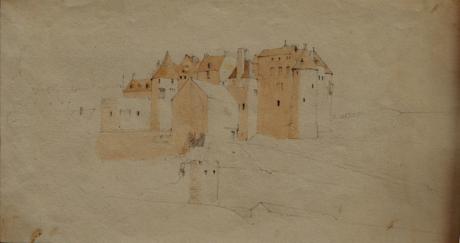The Château de Dieppe is a castle in the French town of Dieppe in the Seine-Maritime département.
The castle was founded in 1188, and was destroyed in 1195. The site was restored in the 14th century. The castle was later in large part reconstructed in 1433 by Charles des Marets. The castle is composed of a quadrangular enclosure with round flanking towers and a lower court adjacent. The large west tower dates perhaps from the 14th century, and served as the keep. Several architectural styles are represented, and flint and sandstone are used in the buildings. A brick bastion and various other buildings have been added to the original enclosure.
The town walls were built around 1360. The walls were extended between 1435 and 1442. Although the town was largely destroyed by an Anglo-Dutch naval bombardment in 1694, the castle survived. Until 1923, the castle housed the Ruffin barracks. It was bought by the town in 1903 and today is home to the Dieppe museum with its collection of ivories (crucifixes, rosaries, statuettes, fans, snuffboxes, etc.), maritime exhibits and the papers and belongings of Camille Saint-Saëns. The castle offers a panoramic view over the town and the coast. The Château de Dieppe has been officially classed since 1862 as a monument historique by the French Ministry of Culture.
Boys was born at Pentonville, London, on 2 January 1803. He was articled to the engraver George Cooke. When his apprenticeship came to an end he went to Paris where he met and came under the influence of Richard Parkes Bonington, who persuaded him to abandon engraving for painting. Some sources describe him as a pupil of Bonington, although William Callow, who later shared a studio with him in Paris, disputed this.
He exhibited at the Royal Academy for the first time in 1824, and in Paris in 1827. In 1830 he went to Brussels, but returned to England on the outbreak of the revolution there. Paying another visit to Paris, he remained there until 1837, and then returned to England in order to lithograph the works of David Roberts and Clarkson Stanfield.
His most important work, Picturesque Architecture in Paris, Ghent, Antwerp, Rouen, etc., a collection of colour lithographs, appeared in 1839, attracting a great deal of admiration.Drawn on the stone by Boys and printed by Charles Joseph Hullmandel, it was described in a review in the Polytechnic Journal as "the first successful effort in chroma-lithography hitherto brought to perfection". King Louis-Philippe sent the artist a ring in recognition of its merits. He also published Original Views of London as it is, drawn and lithographed by himself, (London, 1843). He drew the illustrations to Blackie's History of England, and etched some plates for John Ruskin's Stones of Venice.
Boys was a member of the Institute of Painters in Water Colours, and of several foreign artistic societies. He died in 1874.

